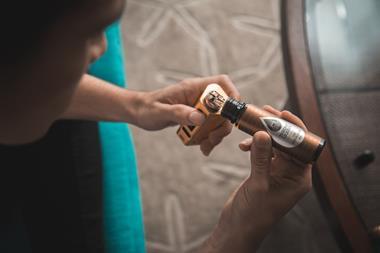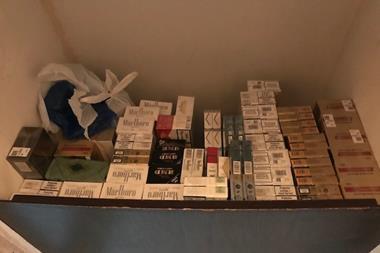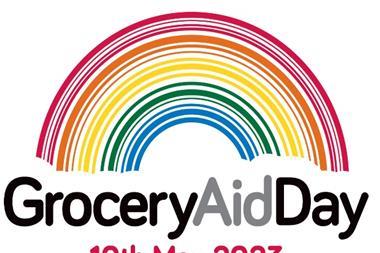Our C-Store Champions are embracing the healthy eating movement and enjoying some nourishing sales from a new category of shoppers
Manny Patel
Manny’s, Long Ditton, Surrey Manny says more shoppers are looking for healthy options, with many teens opting for a piece of fruit over a sugary snack
Andrew Porter
General manager of three Spar stores in Northern Ireland Andrew reports that sales of salads are soaring as demand for fresh food-to-go rivals that of hot food
Ramesh Shingadia
Two Londis stores in Horsham, West Sussex Ramesh ensures his stores provide healthy options within his food missions strategy
Guy Warner
Six Warner’s Budgens stores in the Cotswolds Even white van man is getting into sushi, points out Guy, as all demographics buy into health trends
Have you noticed your shoppers opting for healthier options more frequently?
Manny: Definitely. A lot of people are looking for lactose-free and gluten-free options, and organic foods as well.
Andrew: I’ve noticed there’s been a big change. It’s been building for a few years, but there has been a big change in the past year alone. We have a very strong over-the-counter deli offering and our sales of salads and healthy foods have nearly overtaken the hot food side of the business. That’s absolutely fantastic for us as we can get good margins. There are challenges that come with fresh food, but if you can get it correct it can be very successful.
Ramesh: Yes, although it’s been a gradual move rather than a revolution. People are getting a lot more health conscious and selective in terms of what they choose to eat. I think this is to do partly with the growing awareness of the obesity problem and partly due to manufacturers making consumers more aware and trying to promote their items as being healthy. Also, the media is driving a lot of the awareness.
Guy: I think there’s been a distinct move across the board. The most noticeable move has been in habits around food-for-now and lunchtime. In snacking, you’ve gone from standard crisps and chocolate bars to popcorn, baked crisps, crackers and health food bars. Things that were previously seen as sports nutrition are now becoming an alternative to confectionery for all demographics of shopper.
What demographic of shopper would you say is most on board with the health trend?
Manny: I’d say 18- to 19-year-olds are going for the healthy snacks, such as cereal bars, especially school girls. As they are getting older they are turning from chocolate to healthier replacements. They sometimes will even pick up an apple to munch on their way to school, instead of a sugary snack.
Andrew: Younger females mostly, but also the young men who are gym-goers. They are interested in getting their protein so our salads with plenty of chicken or tuna are popular with them.
Ramesh: I think all shoppers are a bit more aware. Mums are looking at the ingredients in the food they give to their children. Also younger shoppers, such as those in their early 20s, seem to be following the health trend.
Guy: You used to be able to say there was a certain type of shopper who went for the healthy options, but now I would say it’s across the board. Take sushi, for example – you used to think only a certain type of person would go for that option for lunch, but now I’ll see a white van man picking up a pack.
In what ways have you modified your range and store layout to accommodate the trend?
Manny: We’ve got the fruit and veg as you come in the door and the chiller on the right. The fruit is very prominent and we also have a basket of fruit on the counter. I have all the health bars on a stand as you walk up to the counter, and again on the counter, so that they sell as an impulse buy.
Andrew: We have the increased salad range, but we’ve increased our range of ‘healthy’ drinks, such as smoothies. The Naked fruit smoothies are the most popular as they are marketed as being full of ‘super berries’. We also sell punnets of berries, including strawberries, blueberries, blackberries and raspberries. These are really popular for snacking as the shopper can easily eat those like crisps. We brought those in last year and they’ve been extremely popular.
Ramesh: The big area for us is food-to-go and mission solutions. We make sure to provide meal solutions for breakfast, lunch and dinner. We’ve integrated healthy options into these offers. So for breakfast we offer fruit juices and smoothies, for lunch we have salads, water and fruit, and for dinner we offer lighter, low-fat meals and more soft drinks options to replace beer or wine.
Guy: We try to morph our ranges to make them bigger and encompass the healthy options. We don’t have to chop out any products because the market is still there for those products, there’s just an extra market added. So with confectionery, we have added healthy snacking and sports nutrition bars, such as the Nakd bars and Clif bars. With the sandwiches, we’ve added low-calorie salads without lots of mayo. You don’t need to take out entire lines. Usually if you look at your store practically you can find space, either through removing dead products or avoiding duplication.
How much did it cost to make these changes and how much value do you think it has brought to your business?
Manny: It cost me nothing. We haven’t gone out of our way to put up a special display. We’ve got baskets for the fruit which we had already. Most of the stuff we had in the store already so it’s just a case of utilising what we had. You get all sorts of merchandise from the sales reps so you’ve just got to use it in the correct way.
Andrew: It didn’t cost anything. We already had the chilled and counter space. But it has opened up the store to a whole new customer base so it’s brought a huge amount of value to the business.
Ramesh: It costs a little bit more to offer the healthy options, but people are happy to pay more for a fresh and healthy meal if it is good quality so it definitely provides us with value for money as we get good margins.
Guy: The biggest cost has been our time. It takes time to source new products and merchandise them. We also looked around at the competition to see what they’re doing. The value it brings is huge, because it makes you more attractive to a more holistic market. There are people who will choose not to go to a store if they know they can’t get healthy food there and you can’t afford to neglect an entire market.
Are there any specific product trends?
Manny: Various berries are popular now, such as the super berries. I don’t sell them on their own, though, they are just in some of the health bars.
Andrew: The super berries, especially blueberries, are very popular, as well as protein.
Ramesh: I don’t know if the super foods trend has really taken off in the convenience market. People are looking for low-fat, sugar-free and gluten-free products.
Guy: Blueberries are finding their way into everyone’s trollies now. And organic is very important as there are some shoppers who will only buy organic.
What are your best-selling health products?
Manny: Our best-sellers are fruit and the Eat Natural cereal bars.
Andrew: The salads, because people really appreciate having a salad made in front of them, with exactly the ingredients they want.
Ramesh: I would say the salads for lunch have been very popular. That is a good fresh and high-quality option, alongside a punnet of chopped up fruit and a bottle of water.
Guy: Fresh fruit in tubs. The demand for fresh prepared fruit in tubs has gone way past a simple melon salad. The salad pot is becoming like a staple, almost like the new apple. Also, they fall into every shopper mission – snacking, top-up and grocery.
What would be your main advice to any other retailers wanting to buy into this trend?
Manny: It’s really important to put new items on the counter. We always put new products there as that’s the best way to catch the shopper’s attention and the best way to get them to try the product and start that buying habit.
Andrew: You have to have the right staff behind the counter and put on the right display. It’s all about training and planograms. Also, when it comes to bringing new products into store, sampling is very important. We do sampling nearly every week.
Ramesh: I would say that food to go and meal-time solutions are key for convenience retailers. They need to offer healthy solutions for breakfast, lunch and dinner.
Guy: Look at the market – visit your local high street, supermarkets and cafés. This is useful market research and it will show the importance of the health food offer and how prevalent it is. Then extend your range and incorporate the new products into their appropriate category.
How do you merchandise the healthier products you sell in your store?
Manny: We don’t really need to promote them specially. As long as the products are prominent within the store so the customers will see them as they walk around, they will automatically purchase them. That’s worked for us anyway.
Andrew: We sell the punnets of berries for £2.20 each, but we have them on offer at two for £4 and people often go for this option.
Ramesh: When we have a new product or solution in then we will usually have a display at the front of the store and sometimes a member of staff offering samples. Once shoppers have become aware of the product we can then integrate it into the store.
Guy: We merchandise the healthier options we sell within the appropriate fixture. This means the healthy snack bars go with the confectionery; the salads go with the lunch offering. We do have a dedicated gluten-free bay, but the other healthy options are integrated within the category that they belong in.





















No comments yet